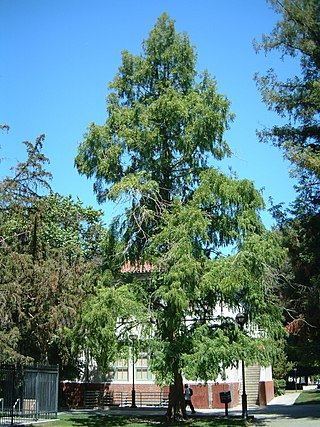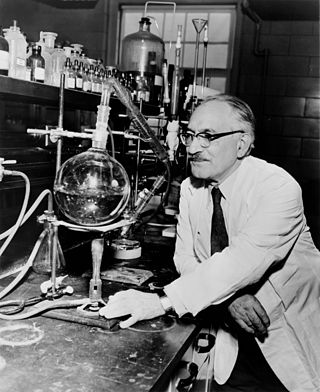Related Research Articles

The Nobel Prize in Physiology or Medicine is awarded yearly by the Nobel Assembly at the Karolinska Institute for outstanding discoveries in physiology or medicine. The Nobel Prize is not a single prize, but five separate prizes that, according to Alfred Nobel's 1895 will, are awarded "to those who, during the preceding year, have conferred the greatest benefit to humankind". Nobel Prizes are awarded in the fields of Physics, Medicine or Physiology, Chemistry, Literature, Economics and Peace.

Streptomycin is an antibiotic medication used to treat a number of bacterial infections, including tuberculosis, Mycobacterium avium complex, endocarditis, brucellosis, Burkholderia infection, plague, tularemia, and rat bite fever. For active tuberculosis it is often given together with isoniazid, rifampicin, and pyrazinamide. It is administered by injection into a vein or muscle.

Neomycin is an aminoglycoside antibiotic that displays bactericidal activity against Gram-negative aerobic bacilli and some anaerobic bacilli where resistance has not yet arisen. It is generally not effective against Gram-positive bacilli and anaerobic Gram-negative bacilli. Neomycin comes in oral and topical formulations, including creams, ointments, and eyedrops. Neomycin belongs to the aminoglycoside class of antibiotics that contain two or more amino sugars connected by glycosidic bonds.

Metasequoia glyptostroboides, the dawn redwood, is a fast-growing, endangered deciduous conifer. It is the sole living species of the genus Metasequoia, one of three genera in the subfamily Sequoioideae of the family Cupressaceae. It now survives in the wild only in wet lower slopes and montane river and stream valleys in the border region of Hubei and Hunan provinces and Chongqing municipality in south-central China, notably in Lichuan county in Hubei. Although the shortest of the redwoods, it can grow to 167 ft (51 m) in height.
The year 1940 in science and technology involved some significant events, listed below.

Laryngoscopy is endoscopy of the larynx, a part of the throat. It is a medical procedure that is used to obtain a view, for example, of the vocal folds and the glottis. Laryngoscopy may be performed to facilitate tracheal intubation during general anaesthesia or cardiopulmonary resuscitation or for surgical procedures on the larynx or other parts of the upper tracheobronchial tree.
The year 1868 in science and technology involved some significant events, listed below.

The year 1945 in science and technology involved some significant events, listed below.
The year 1928 in science and technology involved some significant events, listed below.
The year 1949 in science and technology involved some significant events, listed below.

Selman Abraham Waksman was a Jewish Ukrainian inventor, Nobel Prize laureate, biochemist and microbiologist whose research into the decomposition of organisms that live in soil enabled the discovery of streptomycin and several other antibiotics. A professor of biochemistry and microbiology at Rutgers University for four decades, he discovered several antibiotics, and he introduced procedures that have led to the development of many others. The proceeds earned from the licensing of his patents funded a foundation for microbiological research, which established the Waksman Institute of Microbiology located at the Rutgers University Busch Campus in Piscataway, New Jersey (USA). In 1952, he was awarded the Nobel Prize in Physiology or Medicine for "ingenious, systematic, and successful studies of the soil microbes that led to the discovery of streptomycin." Waksman and his foundation later were sued by Albert Schatz, one of his Ph.D. students and the discoverer of streptomycin, for minimizing Schatz's role in the discovery.

Sir Ernst Boris Chain was a German-born British biochemist and co-recipient of the Nobel Prize in Physiology or Medicine for his work on penicillin.

Albert Israel Schatz was an American microbiologist and academic who discovered streptomycin, the first antibiotic known to be effective for the treatment of tuberculosis. He graduated from Rutgers University in 1942 with a bachelor's degree in soil microbiology, and received his doctorate from Rutgers in 1945. His PhD research led directly to the discovery of streptomycin.

Busch Campus is one of the five sub-campuses at Rutgers University's New Brunswick/Piscataway area campus, and is located entirely within Piscataway, New Jersey, US. Academic facilities and departments centered on this campus are primarily those related to the natural sciences: physics, pharmacy, engineering, psychology, mathematics and statistics, chemistry, geology, and biology. The Rutgers Medical School was also built on this campus in 1966, but four years later in 1970 was separated by the state and merged with the New Jersey Medical School and other health profession schools in Newark and New Brunswick to create the College of Medicine and Dentistry of New Jersey. Rutgers and the medical school, renamed Robert Wood Johnson Medical School in 1986, continued to share the land and facilities on the campus in a slightly irregular arrangement. On July 1, 2013, Robert Wood Johnson Medical School was officially merged back into Rutgers University, along with most of the other schools of UMDNJ, with the exception of the UMDNJ-School of Osteopathic Medicine.

The history of animal testing goes back to the writings of the Ancient Greeks in the 4th and 3rd centuries BCE, with Aristotle and Erasistratus one of the first documented to perform experiments on nonhuman animals. Galen, a physician in 2nd-century Rome, dissected pigs and goats, and is known as the "Father of Vivisection." Avenzoar, an Arabic physician in 12th-century Moorish Spain who also practiced dissection, introduced animal testing as an experimental method of testing surgical procedures before applying them to human patients. Although the exact purpose of the procedure was unclear, a Neolithic surgeon performed trepanation on a cow in 3400-3000 BCE. This is the earliest known surgery to have been performed on an animal, and it is possible that the procedure was done on a dead cow in order for the surgeon to practice their skills.

Streptomyces griseus is a species of bacteria in the genus Streptomyces commonly found in soil. A few strains have been also reported from deep-sea sediments. It is a Gram-positive bacterium with high GC content. Along with most other streptomycetes, S. griseus strains are well known producers of antibiotics and other such commercially significant secondary metabolites. These strains are known to be producers of 32 different structural types of bioactive compounds. Streptomycin, the first antibiotic ever reported from a bacterium, comes from strains of S. griseus. Recently, the whole genome sequence of one of its strains had been completed.
Julian Edmund Davies is a British-born microbiologist and Professor Emeritus in the Department of Microbiology and Immunology at the University of British Columbia.

Elizabeth Bugie Gregory was an American biochemist who co-discovered Streptomycin, the first antibiotic against Mycobacterium tuberculosis in Selman Waksman laboratory at Rutgers University. Waksman went on to win the Nobel Prize for Medicine in 1952 and took the credit for the discovery.
William Hugh Feldman was a doctor of veterinary medicine known for world-renowned achievement in two distinct fields, veterinary pathology and chemotherapy of experimental tuberculosis. He also made important contributions to the treatment of leprosy.
Horton Corwin Hinshaw Sr. was an American pulmonologist, known for the use of streptomycin as the first effective antibiotic for the treatment of tuberculosis (TB).
References
- ↑ Ma, Jinshuang; Shao, Guofan (2003). "Rediscovery of the 'first collection' of the 'Living Fossil', Metasequoia glyptostroboides". Taxon . 52 (3): 585–8. doi:10.2307/3647458. JSTOR 3647458.
- ↑ Copeland, B. Jack, ed. (2006). Colossus: the Secrets of Bletchley Park's Codebreaking Computers. Oxford University Press. ISBN 978-0-19-284055-4.
- ↑ "The Eruption of Parícutin (1943-1952)". How Volcanoes Work. Archived from the original on 2007-06-04. Retrieved 2012-10-23.
- ↑ "Parícutin, Mexico". Volcano World. Archived from the original on 2012-02-06. Retrieved 2012-10-23.
- ↑ "Parícutin: The Birth of a Volcano". Smithsonian National Museum of Natural History. Archived from the original on 2013-01-03. Retrieved 2012-10-23.
- ↑ Comroe, J. H. Jr (1978). "Pay dirt: the story of streptomycin. Part I: from Waksman to Waksman". American Review of Respiratory Disease . 117 (4): 773–781. doi:10.1164/arrd.1978.117.4.773 (inactive 31 January 2024). PMID 417651.
{{cite journal}}: CS1 maint: DOI inactive as of January 2024 (link) - ↑ "Surviving War; Declining Health". Lincoln & Churchill. Lehrman Institute. 2013-11-07. Retrieved 2017-01-21.
- ↑ Neushul, P. (1993). "Science, government, and the mass production of penicillin". Journal of the History of Medicine and Allied Sciences. 48 (4): 371–395. doi:10.1093/jhmas/48.4.371. PMID 8283024.
- ↑ "Hallucinogenic effects of LSD discovered". The History Channel. Archived from the original on 2014-03-11.
- ↑ Kanner, L. (1943). "Autistic disturbances of affective contact". Nervous Child. 2 (4): 217–50. PMID 4880460. Reprinted in: Acta Paedopsychiatrica. 35 (4): 100–36. 1968. PMID 4880460.
{{cite journal}}: CS1 maint: untitled periodical (link) - ↑ Aizawa, Ken (2004). "McCulloch, Warren Sturgis". Dictionary of the Philosophy of Mind. Retrieved 2011-12-03.
- ↑ Moore, Carrie A. (2009-02-11). "Kolff, 'father of artificial organs,' dies at 97". Deseret News . Salt Lake City. Retrieved 2012-06-13.
- ↑ Macintosh, R. R. (1943). "A new laryngoscope". The Lancet . 241 (6233): 205. doi:10.1016/S0140-6736(00)89390-3.
- ↑ Scott, J.; Baker, P. A. (2009). "How did the Macintosh laryngoscope become so popular?". Pediatric Anesthesia. 19 (Supplement 1): 24–9. doi: 10.1111/j.1460-9592.2009.03026.x . PMID 19572841. S2CID 6345531.
- ↑ Flower, Stephen (2002). A Hell Of A Bomb. Tempus. ISBN 978-0-7524-2386-9.
- ↑ McGrath, Kimberley A.; Travers, Bridget E., eds. (1999). World of Invention. Detroit: Thomson Gale. ISBN 978-0-7876-2759-1. Archived from the original on 5 June 2011. Retrieved 27 June 2011.
- ↑ (in Italian, French, and German)Heldner, Paul (21 July 2005). "Guglielminetti, Ernest". Dictionnaire historique de la Suisse. Retrieved 13 February 2021.
- ↑ Arias, Ingrid (2006). Im Dienste der Volksgesundheit: Frauen – Gesundheitswesen – Nationalsozialismus[In the Service of Public Health: Women, Healthcare, Nazism] (in German). Vienna: Verlagshaus der Ärzte. p. 87. ISBN 978-3-90148-886-3.